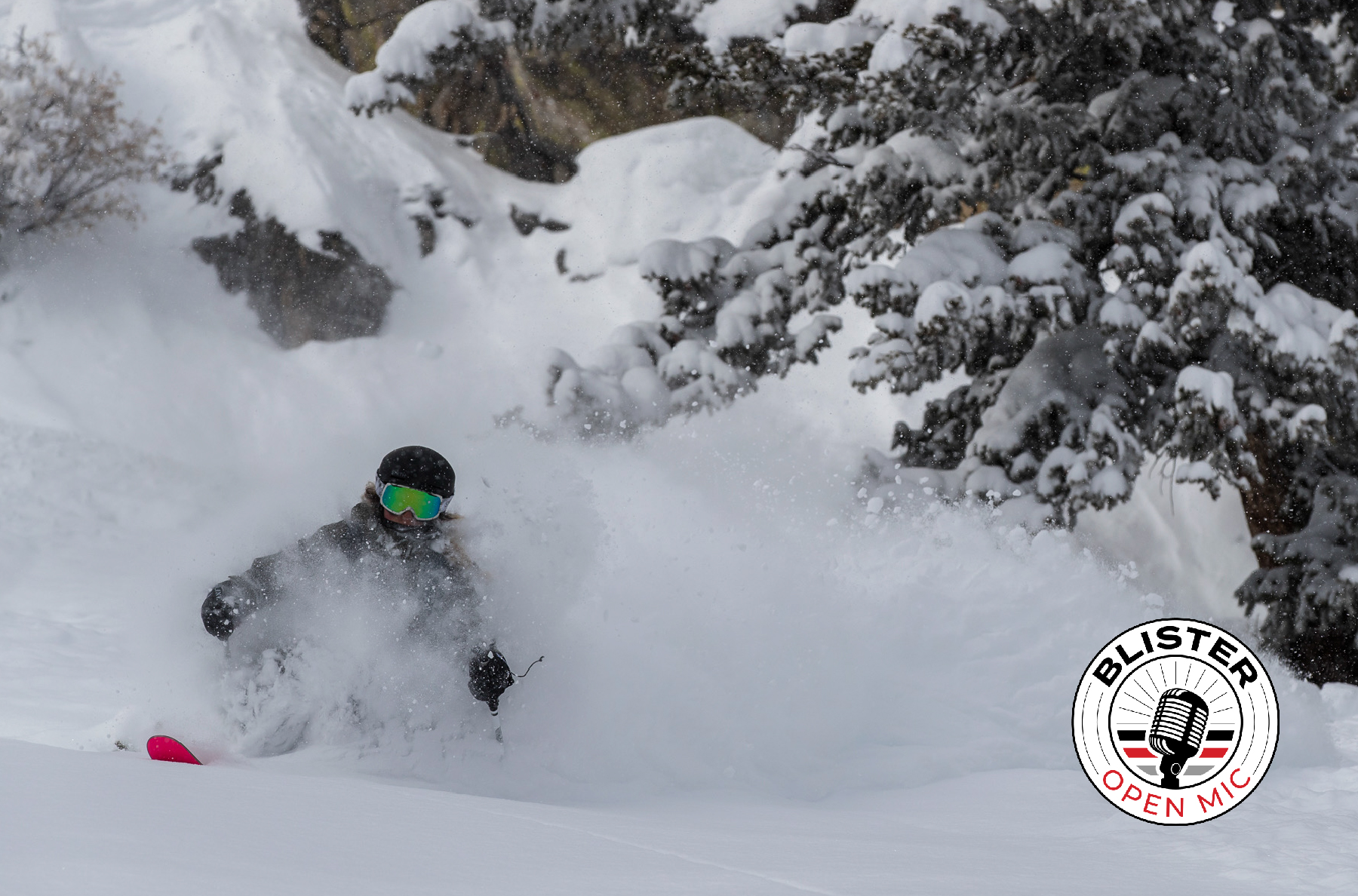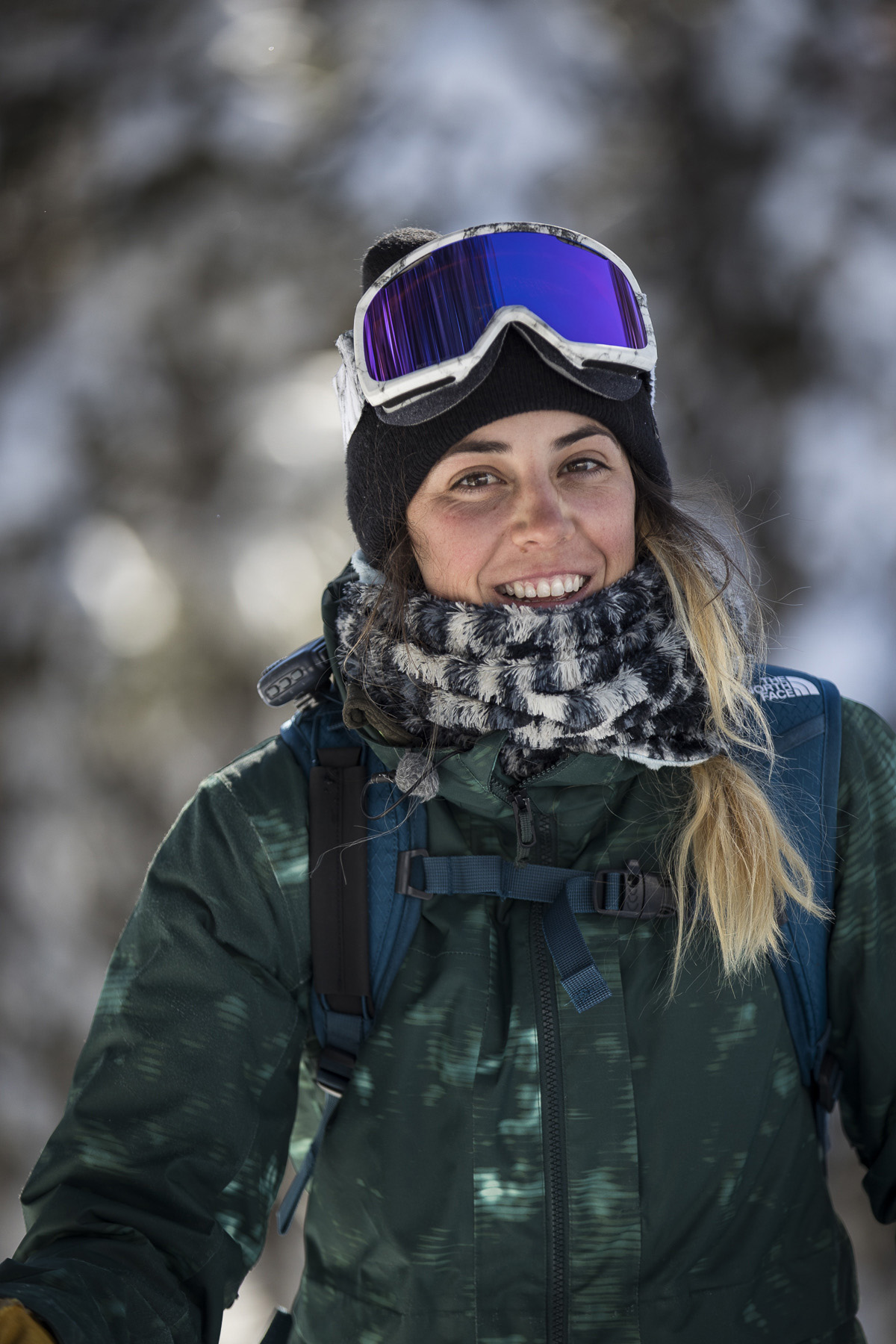Open Mic is the series on BLISTER where we invite various people in the outdoor industry to say what they have to say, and share whatever it is they feel like sharing at this particular point in time.
Today, we hear from Hadley Hammer:
About Hadley Hammer
Hadley Hammer is a professional skier. She is also a reader, writer, and a multitude of other things…

Risk vs. Consequences
If I asked you to put a number on how much risk you took today, could you?
If I asked you to put a number on how much risk you took the last time you climbed a mountain, skied a backcountry couloir, or went ice climbing, could you?
The subject of risk and backcountry skiing dominates avalanche classes, outdoor media, ski films, and trailhead chats. And I can’t think of any interviews I’ve given where my risk tolerance wasn’t questioned.
In his book, Risk Intelligence, Dylan Evans dives into the subject of how good we are as species in correctly identifying risk. His general conclusion? We kinda suck at it. Those numbers you guessed at above, well they were probably wrong.
We feel safer driving than flying.
We pass on sky diving, but we’ll eat burgers once a week.
We buy the expensive TV, but don’t purchase the warranty.
We often conflate a sense of control with the level of risk. For example, we think driving is safer than flying because we are in control versus trusting a pilot. When in fact, flying is statistically much safer.
I know of only two professional athletes who have ever been fully honest about the limits of risk assessment. One is alive, one isn’t.
If “the heart of risk intelligence lies in the ability to gauge the limits of your own knowledge,” are we being honest about how much we can know about how snow and terrain work?
And if we zoom out even further, are we honest with ourselves about knowing how life and death work?
A friend recently confessed to me that he was constantly afraid that his wife was going to die in the mountains. She’s a mountain guide. A conservative one. But he knows how the game works: plenty of ‘safe’ guides die, plenty of risky ones live. Accidents happen.
He asked what I thought about risk now that I’ve had a first hand account of when the person you love fails to calculate the climbing risk correctly and dies.
I would say my risk tolerance is low. But more so, I believe I’m like everyone else, and am not able to accurately calculate risk in the mountains outside of the obvious red flags and green lights. I feel, however, that there is a place where I — and you too — could have some control. And that’s what my friend and I talked about the rest of that day. We talked not about risk, but about consequences.
Evans says: “Our ability to cope with uncertainty is one of the most important requirements for success in life, yet also one of the most neglected. We may not appreciate just how often we’re required to exercise it, and how much impact our ability to do so can have on our lives, and even on the whole of society.”
We — you and me, the outdoor community — talk so much about risk, but so rarely about consequences. We have so little control of the former, and so much more control of the latter.

If “the heart of risk intelligence lies in the ability to gauge the limits of your own knowledge,” then avalanche education classes, beacon practices, having an intimate knowledge of your gear, your partners, the terrain you ski, the weather, your emotional well being, and heuristic traps will increase your knowledge. But there is a chance an accident will still happen anyways — and there will be consequences — for you and for the people who love you.
Consequences include death and injury. You might feel those consequences, but in the worst case, you will be gone and it’s the people you love who will have to feel and deal with them.
Here is where I think we have more control: we can take steps to ensure expenses like hospital bills or funeral expenses are covered. We can control whether or not we leave our loved ones searching for our passwords. We can control if our family or friends can go through their grieving process knowing that we loved them unconditionally.
So, while autumn turns to winter, and you start preparing your legs and mind and avalanche skillset for the winter to come, I’ve included another checklist to go through. A “Consequences” checklist. Some of these steps, you may have already done. Others, you may have never considered. Some might seem a bit morbid, and some might require a hard conversation or two. But I think this checklist represents a new step forward in terms of what it means to recreate responsibly. And it’s the kindest thing we can do for our loved ones.
8-Step Checklist
Step 1: Injury Insurance
Health insurance downright sucks in the U.S. Once I had knee surgery in Wyoming, and even with coverage, it still cost me something like $28,000 on top of my annual $8,000 insurance premium.
I also had knee surgery in Europe that cost me $6,000 on top of a $600 annual fee, though it did come with a homemade cake and three recovery days in the hospital. That’s a pretty good deal compared to what that would have cost in the USA, but I still had to pay $6,600 out of pocket for the procedure and care.
Blister (yes the site you’re currently reading) offers injury insurance through its BLISTER+ membership that covers 20 of the activities we love: skiing, snowboarding cycling, mountain biking, climbing, snowmobiling, fishing, etc. It covers up to $25,000 of medical expenses and medical transportation / backcountry evacuations per incident, anywhere in the world. You can read all about it here, but in short, I personally could have saved over $40,000 in hospital bills I’ve paid while being a professional skier if BLISTER+ existed at the time. (Shoot I might have even had a chance to buy an outhouse in Jackson!)
While it always amazes me the way communities support each other, it worries me how platforms like GoFundMe have become the new default. Which brings us to the topic of life insurance.
Step 2: Life Insurance
How many guides and active mountain athletes have it? You’re making the choices in the mountains, but you’re also making choices for your loved ones. I think of life insurance as a way of saying thank you to the people that love me and put up with my choices. My own plan isn’t expensive — it’s $21 dollars a month, but will easily cover funeral costs (which average between $7,000 to $12,000 in the US), medical costs, and even designates an amount of money for my closest friends and family to take one trip all together in memory. Life insurance works particularly well for unexpected, “early” deaths, when there are people who depend on you.
Step 3: Passwords
Are your passwords all in one place and does someone know where that place is? Anyone that has suddenly lost a loved one can tell you that it is a complete pain in the ass to get access to their computers, phones, bank accounts, etc. It involves hours — and months — of paperwork, phone calls, and sometimes lawyers. Don’t make the people you love have to go on a wild goose chase to cancel something as simple as a Netflix subscription. They will be tired enough.
Step 4: Advanced Directives
DNR (do not resuscitate) and other end of life issues are tricky. I’ve watched a family be torn apart trying to decide whether or not their loved one should stay on life support. It is certainly not my place to give any advice here on this matter, but I urge you to have this conversation with your family or partners and take the steps to sign a DNR at your hospital if that is your decision.
Step 5: Wills
If you don’t own much, a handwritten will or one created from an online template would probably suffice. If you have significant assets, working with a lawyer is really the best way to go. It’s an investment, but it also can — and should — be thought of as a gift to your loved ones. It will limit them having to make numerous difficult decisions without you. Grief can express itself in anger, and a will can help alleviate family tension around your stuff.
Step 6: Stuff
Speaking of stuff, one thing I learned from my partner David is how much I appreciated how little of it he had — just enough for everyone to have something to remember him by, not so much that it was a burden. Going through your loved one’s stuff is nice only to a certain point, then it becomes painful, and then it becomes arduous. Clean out your closet every once in a while so your mom doesn’t have to make the emotionally charged decision about all your t-shirts.
Step 7: Letters
One of the obvious but still shocking consequences of death is the end of all communication with your loved one. After David died, I started a collection of letters to people I love, only to be read when I die. It sounds morbid, but honestly it’s such a beautiful process to sit down and tell people the ways they impacted my life and how much I love them.
Step 8: Living Well
There are some rather ineffable parts of this “Consequences” checklist, too. Things like spending quality time with people. Taking the extra effort to visit friends. Having one more cup of coffee.
The memories I have of people I love who are gone are some of my most precious possessions. I no longer hesitate when I have the chance to see the old friend who is in town for a short visit, or to stay that extra hour in conversation with a loved one, even when my inbox is calling.
Final Thoughts
Mountain sports are risky, and we might not ever be able to calculate how risky they are. But those risks — and their consequences — come with responsibilities that every single one of us needs to acknowledge and act on. Doing so can help us organize our lives, reduce the burden on our communities and loved ones, and in the end, help us all live better.


Very well thought out. Except for writing letters, which is a male aversion thing at my age, I’m in order. Maybe I’ll chat with my daily ski buds to make sure we’re all in the same place